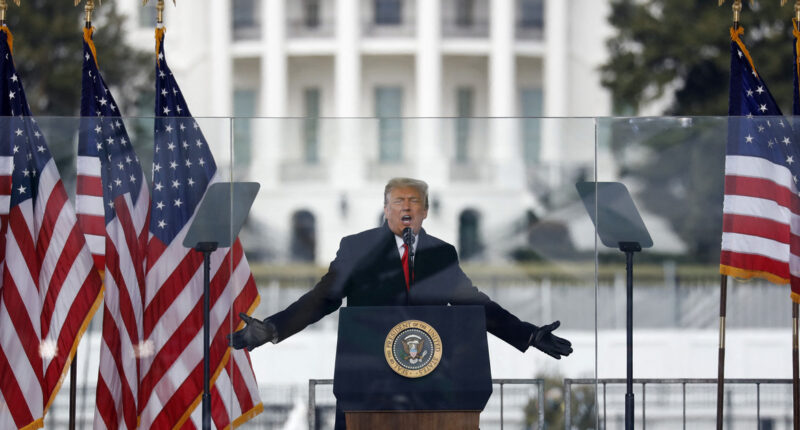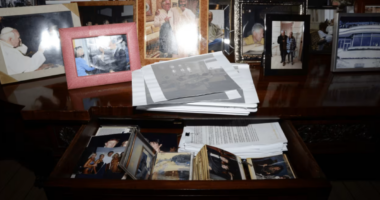Share this @internewscast.com
On January 6, 2021, U.S. President Donald Trump addresses his supporters at the Save America Rally held on the Ellipse near the White House in Washington. Photo by Yuri Gripas/Abaca/Sipa USA (Sipa through AP Images).
President Donald Trump has followed through on a subject he raised during his 2024 campaign, issuing an executive order to prosecute those who set the American flag on fire. While a far cry from the jurisprudence of the late conservative Justice Antonin Scalia, it”s also a threat to loosen free speech protections that benefited Trump himself in the aftermath of Jan. 6 and during his reelection campaign.
In the publicized executive order, Trump stated that because the flag is “a special symbol in our national life” the desecration thereof is a “uniquely offensive and provocative” act that “may incite violence and riot.”
Next, the order paid limited attention to the U.S. Supreme Court’s 1989 ruling in Texas v. Johnson, which held that Gregory “Joey” Lee Johnson’s criminal conviction for “flag desecration is inconsistent with the First Amendment” — upholding his right to freely express his anti-Reagan administration political speech even if that manner of that expression was seriously offensive to a broad swath of Americans.
Of note, the Texas v. Johnson court, in which the late conservative Justice Antonin Scalia was a prominent member of the razor-thin majority, specifically rejected the notion that the government could “assume that every expression of a provocative idea will incite a riot,” without first looking to the “actual circumstances surrounding the expression.” Law&Crime readers may recall that Johnson was arrested again in 2019 after burning a flag on July 4 outside of the White House, before that case was swiftly dropped.
The Johnson court expressly declined to disturb the major precedent of Brandenburg v. Ohio, which drew a distinction between a pro-Ku Klux Klan rally and speech “directed to inciting or producing imminent lawless action and is likely to incite or produce such action.”
“To accept Texas’ arguments that it need only demonstrate ‘the potential for a breach of the peace,’ and that every flag burning necessarily possesses that potential, would be to eviscerate our holding in Brandenburg,” the Johnson court said. “This we decline to do.”
Some of Trump’s most public-facing defenders, whether during his second failed impeachment or in legal commentary, said Brandenburg shielded Trump from any claims that he incited the Jan. 6 attack on the Capitol, which followed the president’s speech from the Ellipse that afternoon. During the speech, Trump told an angry crowd of his supporters that the 2020 election was stolen and “if you don’t fight like hell, you’re not going to have a country anymore.”
“I know that everyone here will soon be marching over to the Capitol building to peacefully and patriotically make your voices heard,” he also said.
Questions of presidential immunity aside, George Washington University law professor Jonathan Turley, for instance, defended the president and remarked that the speech was “entirely protected under a case called Brandenburg and the First Amendment.”
And Brandenburg also helped Trump and Vice President JD Vance stave off allegations that their falsehoods on the campaign trail about Haitian immigrants in Ohio “eating the cats” amounted to felony inducing panic.
“Freedom of speech is among our most precious and protected constitutional rights. It’s enshrined in the 1st Amendment of the United States Constitution. Indeed, the United States and Ohio Supreme Courts have recognized the importance of speech, even when it stirs people to anger,” a panel of Ohio judges ruled, citing Brandenburg and Texas v. Johnson.
Trump’s executive order has forged ahead nonetheless, perhaps teeing up the current Supreme Court to eventually decide what the Johnson court wouldn’t: whether flag burning is “fighting words,” which “that by their very utterance inflict injury or tend to incite an immediate breach of the peace,” or whether flag burning is by its nature “likely” to incite imminent lawless action and is therefore illegal.
This flag burning executive order has it all:
Symbolic expression is “violence” against the nation.
Heckler’s veto justifications for censorship.
Misinterpretation/narrowing of the Brandenburg incitement standard.
A revitalization of the “fighting words” doctrine. pic.twitter.com/d71Xh087wV
— Nico Perrino (@NicoPerrino) August 25, 2025
Brandenburg v. Ohio told America half a century ago it has to put up with the Klan and cross burnings, and the country survived. https://t.co/xFzcNc0DvV
— Matt Taibbi (@mtaibbi) August 25, 2025
“Notwithstanding the Supreme Court’s rulings on First Amendment protections, the Court has never held that American Flag desecration conducted in a manner that is likely to incite imminent lawless action or that is an action amounting to ‘fighting words’ is constitutionally protected. See Texas v. Johnson, 491 U.S. 397, 408-10 (1989),” the executive order said, claiming U.S. Attorney General Pam Bondi would enforce the directive “consistent with the First Amendment” and through “litigation” as needed.
“In cases where the Department of Justice or another executive department or agency (agency) determines that an instance of American Flag desecration may violate an applicable State or local law, such as open burning restrictions, disorderly conduct laws, or destruction of property laws, the agency shall refer the matter to the appropriate State or local authority for potential action,” the order said. “To the maximum extent permitted by the Constitution, the Attorney General shall vigorously prosecute those who violate our laws in ways that involve desecrating the American Flag, and may pursue litigation to clarify the scope of the First Amendment exceptions in this area.”
Prior to his second term, Trump openly advocated for one-year jail sentences for anyone who dares “desecrate the American flag,” remarking: “Now, people will say ‘Oh, it’s unconstitutional.’ Those are stupid people. Those are stupid people that say that.”
He next signaled that Congress would have to play a leading role — which it hasn’t.
“We have to work in Congress to get a one-year jail sentence. When they’re allowed to stomp on the flag and put lighter fluid on the flag and set it afire,” he said, “when you’re allowed to do that—you get a one-year jail sentence and you’ll never see it again.”
After Trump’s executive order threatened prosecutions, however, someone burned a flag.
As recently as Monday, and in striking similarity to decades-old protests following a congressional attempt to ban flag burning, Jay Carey, a retired U.S. Army veteran, was handcuffed in Lafayette Park outside of the White House, after burning an American flag.
Video from the scene showed him articulating SCOTUS’ 1989 holding that flag burning was protected expression under the First Amendment.
“I’m being detained because I expressed my First Amendment right to burn the United States flag in public, not causing harm or causing any danger to any citizens or personnel in the area,” Carey said.
The video footage showed that after he lit the flag on fire in defiance of Trump, he said over a bullhorn: “I do this for every single one of you American citizens. We burn this flag in protest to that president who feels it’s his right to do whatever he wants, make whatever law he wants, regardless of whether it’s legal or illegal.”
“It is our First Amendment right to burn this flag, regardless of what the president says,” he added, before the U.S. Secret Service led him away in handcuffs.
Scalia, the justice Trump implicitly lumped into a class of “stupid people” who defend flag burning, would decades later explain why he sided with Johnson: America is not ruled by a kingship, but was founded to escape one.
“You should be in no doubt that, patriotic conservative that I am, I detest the burning of the nation’s flag—and if I were king I would make it a crime,” he said in 2012. “But as I understand the First Amendment, it guarantees the right to express contempt for the government, the Congress, the Supreme Court, even the nation and the nation’s flag.”
When running for president for the first time, Trump vowed to “appoint judges very much in the model of Justice Scalia.”









!['Gonna get [her] back in check': Mayor acquitted of beating daughter unconscious has harsh words for her, says he's going to be 'man of the house'](https://internewscast.com/wp-content/uploads/2025/12/Gonna-get-her-back-in-check-Mayor-acquitted-of-beating-380x200.jpg)





